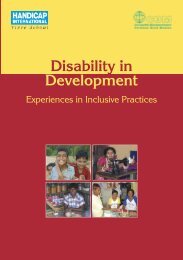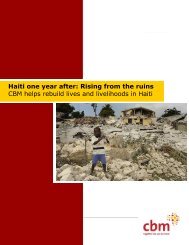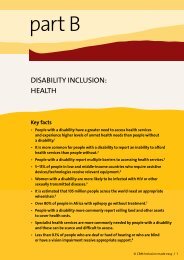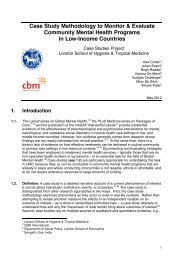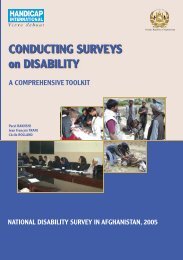Vision 2020 - World Health Organization
Vision 2020 - World Health Organization
Vision 2020 - World Health Organization
Create successful ePaper yourself
Turn your PDF publications into a flip-book with our unique Google optimized e-Paper software.
VISION <strong>2020</strong> GLOBAL INITIATIVE FOR THE ELIMINATION OF AVOIDABLE BLINDNESS: ACTION PLAN 2006–2011<br />
3.6 COORDINATION AT GLOBAL,<br />
REGIONAL AND NATIONAL LEVELS<br />
Despite its relatively short history, VISION <strong>2020</strong> has already demonstrated how global collaboration and<br />
partnership can bring about lasting improvement in blindness prevention. During implementation of the<br />
initiative, however, a number of issues were identifi ed that must be addressed to further strengthen some<br />
areas of WHO–IAPB coordination and information-sharing at all levels, including actual and potential<br />
partners, such as professional groups. It was found that some health-care providers involved in VISION<br />
<strong>2020</strong> activities had insuffi cient understanding of the structure and operation of VISION <strong>2020</strong> for the<br />
prevention of blindness, and better communication among all stakeholders is needed. It is important<br />
to ensure that appropriate messages are delivered by the most appropriate people.<br />
Certain aspects of the coordination of VISION <strong>2020</strong> at global, regional and national levels need to<br />
be clarifi ed by explaining how different stakeholders work together. In addition, a more consistent,<br />
equitable system of support is required for regional coordination by WHO and IAPB personnel. Establishing<br />
stronger links between IAPB and WHO regional and country offi ces is likely to achieve these<br />
and other measures. Similarly, the structure, purpose and role of national VISION <strong>2020</strong> coordinating<br />
bodies should be further clarifi ed and strengthened. In this respect, the job descriptions of national<br />
coordinators should be better defi ned and greater support given to them.<br />
3.7 MONITORING AND IMPACT<br />
ASSESSMENT<br />
Robust mechanisms for monitoring and evaluation are needed at all levels of VISION <strong>2020</strong> to demonstrate<br />
progress. This has been identifi ed as a weakness of the global initiative. Thus, monitoring<br />
and evaluation of the impact of VISION <strong>2020</strong> at regional, national and subnational levels, especially<br />
the collection of data on eye-care services, require strengthening. If progress in all the activities<br />
of VISION <strong>2020</strong> is to continue and accelerate, greater support will have to be provided to national<br />
coordinators in collecting and analysing data. Increased efforts to collect and make available data at<br />
district, country and regional levels is a critical requirement for the success of VISION <strong>2020</strong>, as good<br />
information helps ensure that blindness prevention and treatment activities are directed to areas that<br />
need them the most.<br />
A set of indicators for monitoring the progress of VISION <strong>2020</strong> was developed in 2002 and revised in<br />
late 2006. They are now available for fi eld testing (Annex IV).<br />
60






